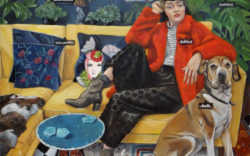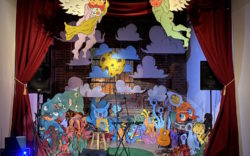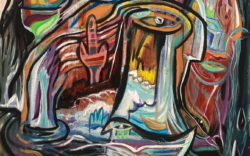The Lamar Dodd School of Art opened three new exhibitions this month, each developing narratives around material abstraction’s ability to shift perceptions of bodies and the spaces they occupy.
“Legion Pool” by Athens artist Carol John, on view in the Bridge Gallery, tells the story of a muggy summer’s day at Legion Pool, a community space located near the University of Georgia’s Tate Student Center. Each painting works collectively to reveal playful vocabulary through abstract marks that describe the elements of Legion Pool that can’t quite be put into words: the sensation of repetitive laps, the weight of the atmosphere on a hot day, how memory forms during the summer.
John’s main work is a long, unstretched piece of canvas, with the bottom corners unfastened, allowing the lower edge to lift from the wall. Large blue rectangles of heavy, sticky aquamarine and light, cool phthalo surround a hot orange field of paint that frames stacks of clumsy pool tile patterns. One could be looking into Legion Pool or completely submerged in it.
The rest of the works in “Legion Pool” employ repetitions of circles, whimsical marks left by John’s elegant brushstrokes and tensions of contrasting greens, pinks, oranges, blues and reds that have been worked into patches of paint to create unity and variety across each of the canvases. Smaller paintings of a similar style finish off the experience of “Legion Pool” and give viewers space to dwell on how arrangements of textures, form and color lead into phenomenal experiences.
In the Suite Gallery, Mac Balentine’s show “Fool-ectomy” is a plethora of pleasurable smells and sensual textures pointing to queer constructions of the sensuous body. The title of the show is derived from Narrenliteratur, or fool’s literature, from Renaissance-era Germany that separates queer individuals and those with mental illnesses into the category “fool.”
“Fool-ectomy” calls out the development of architectural partitioning of public and private (clean and unclean) modes of the body as constructed within early Greek architecture through the use of veils, faux pillars and stone marble or brick patterns. Balentine combines these pieces of architecture with sensual materials like latex, cloth, Air Delights urinal fresheners and three-dimensional renderings of veils and toilet seat rims to deconstruct this partitioning into a fluid, playful space where orifice and bodily function are not only acknowledged, but become active players in breaking apart previously constructed modes of “dirty and clean.”
The multimedia floor piece “Tappen” is comprised of a mattress adorned with rose-gold glass wall bricks; white felt cloth; black, blue, pink and neutral latex material; a worn, hot-pink quilt; and a repetitive print of the Ultra Charmin toilet paper bear cuddling pure white toilet paper. This piece, stretching across the floor, actively deconstructs the fool. The fool is now fluid, master of material, master of queer reproduction. The folds of latex, combined with sexually tender modes of cloth, are mirrored by hanging latex pieces titled “Gummy Shark” and “Stretch.” Computer-generated prints, titled “Enema” and “Dry,” connect themes of bodily excrement and fluid concepts of architectural spaces in which queer bodies might exist.
In the Margie E. West Gallery, there is a different queering of the body in Alex McClay and Sam Regal’s show “Turbulent Femme || towards a radical future.” The show unapologetically gives femme space to exist in embodied and disembodied form. Femme draws from an intersectional re-understanding of femininity, inclusive of effeminate male, queer and non-binary bodies.
On the right and left walls of the gallery are 50 paper panties, each made of handmade paper and adorned with a different way to say “no”: “bitch, please,” “(silence),” “I’d rather die,” “nope.” On the far back wall are motion-activated LED fan lights that flash poetic phrases: “Cheeky Brazillian Underwear,” “Strangers’ Wedding Video,” “I’m gay.” On the gallery’s floor is a living room with a couch, coffee table, plush chair, television, kitsch trophy with underwear and various intimate and junk items, including condoms, soda cans, chips and candy wrappers. Projections paint this installation with phrases of femme pleasure and desire: “I am your cushions,” “A couch is made for kissing,” “Feast from Voyeur’s Rich Shame Banquet.” Behind this piece, a video of Alex McClay’s shadowed profile plays with and swallows the animated phrase “this is my body.”
In “Turbulent Femme,” sound, volume and poetry are powerful media for understanding and existing within the queer (or fluid) nature of femme identity. The exhibition is embedded within an institutional structure, but it loudly refuses a neo-patriarchal gaze. The show insists on discovering methods of existing as a femme body for femme bodies within the fluidity (or queerness) of femme.
All three exhibitions will remain on view through Friday, Oct. 4, and a Lunchtime Gallery Talk for “Turbulent Femme” will be held on Tuesday, Oct. 1 at 12 p.m.
Like what you just read? Support Flagpole by making a donation today. Every dollar you give helps fund our ongoing mission to provide Athens with quality, independent journalism.










